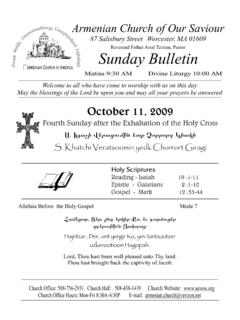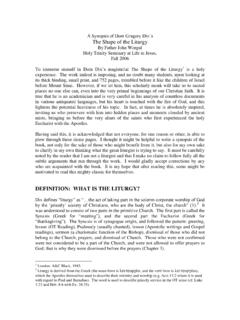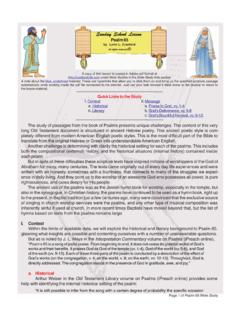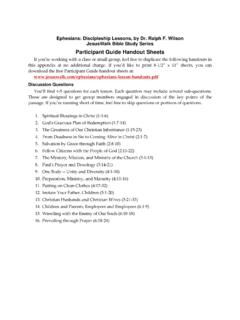Transcription of Exorcism - Morse Covenant Church
1 ExorcismSaint Francis exorcised demons in Arezzo, fresco of GiottoExorcism (from Late Latin exorcismus, from Greek exorkizein - to adjure) is the practice of evicting demons or other evil spiritual entities from a person or place which they are believed to have possessed (taken control of). The practice is quite ancient and part of the belief system of many person performing the Exorcism , known as an exorcist, is often a member of the clergy, or an individual thought to be graced with special powers or skills. The exorcist may use prayers, and religious material, such as set formulas, gestures, symbols, icons, amulets, The exorcist often invokes God, Jesus and/or several different angels and archangels to intervene with the general, possessed persons are not regarded as evil in themselves, nor wholly responsible for their actions.
2 Therefore practitioners regard Exorcism more as a cure than as a punishment. The mainstream rituals usually take this into account, making sure that there is no violence to the possessed, only that they be tied down if there is potential for violence[1].HistoryThe concept of possession by evil spirits and the practice of Exorcism are very ancient and were widespread, and may have originated in prehistoric Shamanistic Christian New Testament includes Exorcism among the miracles performed by Jesus. Because of this precedent, demonic possession was part of the belief system of Christianity since its beginning, and Exorcism is still a recognized practice of Catholicism, Eastern Orthodox and some Protestant sects. The Church of England also has an official exorcist in each diocese. [2]After the enlightenment, the practice of Exorcism has diminished in its importance to most religious groups and its use has decreased, especially in western society.
3 Generally, in the 20th century its use was found mainly in Eastern Europe and Africa, with some cases gaining media coverage; Anneliese Michel is perhaps the most recent of these. This is due mainly to the study of psychology and the functioning and structure of the human mind. Many of the cases that in the past which were candidates for Exorcism are often explained to be the products of mental illness, and are handled as in 1973 the motion picture The Exorcist came out, and the idea of Exorcisms became thrust into the limelight. After its release a very large response came from the public in the United States and Europe, and belief in Demon Possession and Exorcisms found a place in contemporary society. Belief in the validity of the practice became less of a radical idea, and more widespread.
4 [3] Exorcism in ChristianityJesusIn the time of Jesus, non-New Testament Jewish sources report of exorcisms done by administering drugs with poisonous root extracts or other by making sacrifices. (Josephus, "B. J." vii. 6, 3; Sanh. 65b). They do not report of Jesus being an exorcist, but do mention that exorcisms were done by the Essene branch of Judaism (Dead Sea Scrolls at Qumran).Roman CatholicismPainting by Francisco Goya of Saint Francis Borgia performing an Catholic Church revised the Rite of Exorcism in January 1999, although the traditional Rite of Exorcism in Latin is allowed as an option. The act of Exorcism is considered to be an incredibly dangerous spiritual task; the ritual assumes that possessed persons retain their free-will, though the demon may hold control over their physical body, and involves prayers, blessings, and invocations with the use of the document Of Exorcisms and Certain Supplications.
5 Other formulas may have been used in the past, such as the Benedictine Vade retro satana. In the modern era, the Catholic Church authorizes Exorcism rarely, approaching would-be cases with the presumption that mental or physical illness is in play. In mild cases the Chaplet of Saint Michael should be 1974, the Church of England set up the "Deliverance Ministry". As part of its creation every diocese in the country was equipped a team trained in both Exorcism and psychiatry. According to its representatives most cases brought before it have conventional explanations and actual exorcisms are quite rare, though sometimes blessings are given to people for psychological reasons. [2]In The Episcopal Church the Book of Occasional Services discusses provision for Exorcism ; but it does not indicate any specific rite, nor does it establish an office of "exorcist".
6 [7] Diocesan exorcists usually continue in their role when they have retired from all other Church duties. Anglican priests may not perform an Exorcism without permission from the Diocesan bishop. Is not usually performed unless the bishop and his team of specialists (including a psychiatrist and physician) have approved denominationsSome Protestant denominations also recognize possession and Exorcism , although the practice is generally less formalized than it is in the Catholic Church . The Methodist Church also has appointed people in place for use in such circumstances[8]. While some denominations perform Exorcism very sparingly and cautiously, some may perform it almost routinely, as part of regular religious M. Scott Peck researched exorcisms (initially in an effort to disprove demonic possession), and claims to have conducted two himself.
7 He concluded that the Christian concept of possession was a genuine phenomenon. He derived diagnostic criteria somewhat different from those used by the Roman Catholic Church . He also claimed to see differences in Exorcism procedures and progression. After his experiences and in an attempt to get his research validated, he has attempted to get the psychiatric community to add the definition of "Evil" to the DSMIV[9].DeliveranceIn the less formalized sections of Protestant denominations the ritual can take many forms and belief structures, especially in Charismatic movement. The most common of these is the Deliverance ceremony. This differs from the Exorcism ceremony by the fact that the Devil may have gotten a foothold, into a persons life rather than gaining complete control if complete control has been gained a full fledged Exorcism is necessary.
8 However a "spirit filled Christian" can not be possessed based on their beliefs. Within this belief structure the reasons for the devil to get a foothold are usually explained to be some sort of deviation from theological doctrine or because of pre-conversion activities (like dealing with the occult) [10] [11]The method for determining if a person needs a Deliverance is done by having someone present who has the gift of Discernments of Spirits. This is a gift of the Holy Spirit from Cor. 1:12 that allows a person to "sense" in some way an evil presence[12]. While the initial diagnosis is usually uncontested by the congregation, when many people are endowed with this gift in a single congregation results may vary[13].Fr. Gabriele Amorth references these people calling them "seers and Sensitives" and uses them on many occasions; they have the ability to detect an evil presence.
9 He notes however that "They are not always right: their "feelings" must be checked out." In his examples they are able to detect the events that caused the Demon to enter, or are able to discover the evil object that has cursed the individual. He notes that "they are always Humble."[14]







